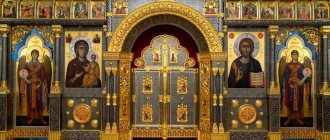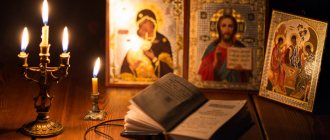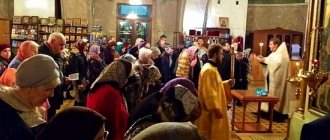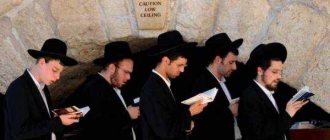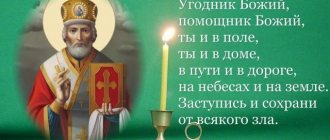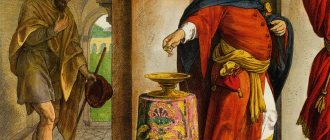Siddur "Gate of Prayer"
(Hebrew: שערי תפילה) – Jewish prayer book siddur with a modern translation into Russian and commentary, published by the editors of “Mahanaim” [1] edited by Pinchas Polonsky, one of the most popular Jewish prayer books in Russian.
Siddur "Gate of Prayer" Nusach Ashkenaz Siddur "Gate of Prayer". Nusah Sfarad Siddur "Gate of Prayer". Nusach Ashkenaz with full transliteration of Siddur "Gate of Prayer". Nusach Ashkenaz with full transliteration in gift packaging Machzor “Gate of Repentance”. Makhzor “Gate of Repentance” in gift format
Name
The name seder (siddur) tefillah was established by the gaons and originally applied to all types of prayer books, coinciding with the concept of machzor. In a number of communities, the distinction between the two types of prayer books is not made to this day. The modern custom of the Ashkenazim (and, under their influence, some Sephardic communities) is to distinguish between the siddur (plural siddurim), containing only the regular prayers, and the machzor (plural machzorim), containing also piyut, in most cases related to holidays, arose quite late.
Yemenite Jews call the prayer book for all days quiet
(from the verb lihlol - `to include`, `to cover`).
Formation of the siddur
All siddurim are designed for a specific version (nussah) of the liturgy. The first regular order of prayers is contained in the second part of the late Talmudic treatise Sofrim, which is a compilation of the translation of the first geons. The first real prayer book, however, was the Seder Rav Amram Gaon (Rabbi Amram Gaon's Prayer Book, 9th century). This siddur, compiled at the request of the Jews of Spain, contains regular prayers for the entire yearly cycle - for weekdays, Saturdays, new moons, fasts, Chanukah, Purim and all holidays - along with the corresponding halahot that precedes each section. At the end of the siddur there are blessings and special prayers for weddings, circumcisions, redemption of the firstborn and burial. All surviving copies of this siddur differ from each other, reflecting the characteristics of the liturgy that the copyist adhered to.
Siddur Saadi Gaon (“Siddur Saadi Gaon”), written a hundred years later, contains, along with the texts of prayers, the corresponding halahot in Arabic (for the Jews of Egypt). It reflects the nussah of the geons of Babylonia (with some influence from the version of the liturgy adopted in Egypt). The logical, methodical order of this prayer book, which differs from the usual calendar order, was not generally accepted, which perhaps explains the limited distribution of this siddur. Another prayer book, which was compiled in the 11th century. Hay ben Srira, has not survived, except for a few quotations from him in halakhic literature.
The so-called “Siddur Rashi”, which arose in the 11th–12th centuries. in the Rashi school, does not contain the text of the prayers, but only halakhic material with full Talmudic justification. “Siddur ha-tefillot”, appended by Maimonides to his work “Mishneh Torah”, is also not an authentic prayer book, but a collection of variant prayers from which a siddur can be compiled; his nussah was apparently accepted at that time in Egypt, as well as in Yemen; it is very different from the one adopted by the Jews of Spain.
In contrast to these books, Makhzor Vitri (12th century, see Makhzor) is a siddur in the full sense of the word. It contains the text of all regular prayers, according to the version of the liturgy adopted in Northern France and close to that accepted in Germany.
Many manuscripts of prayer books have survived, reflecting other versions of the liturgy.
Siddur concept
The concept of the siddur was as follows:
- a clear and understandable translation into Russian, not for the purpose of academic correspondence to the Hebrew text, but from the point of view of ease of reading and understanding of the meaning. Therefore, from the very beginning, the translators refused to translate too literally, to put words in brackets for coherence, as was done in other translations of siddurs, etc.
- An important feature is also detailed headings that help you navigate through prayer and a detailed table of contents based on them.
- the commentary was supposed to reflect the meaning of the prayers for an intelligent Russian-speaking reader, and not for academic study, so a lot of attention was paid to the meaning of the prayers, their place in the history of Jewish liturgy and the history of Jewish culture, their origin, etc.
- A special system of instructions was developed to make it easier for the reader to participate in the synagogue service. Special graphics indicating where they sit, stand, and what prayers are read only in the minyan.
- at the end of the siddur there was a reference apparatus indicating the specifics of prayers on certain days, etc.
All this made it the most convenient Jewish prayer book in Russian. The Siddur was called the “Gateway of Prayer,” which emphasized its beginner-friendly nature.
The first edition of the siddur was published in 1992, and very quickly it became the most popular Jewish prayer book with translation into Russian, and remains so to this day.
Comments on prayers
Simultaneously with the compilation of the oldest prayer books, commentaries on the texts of prayers appeared. In the Siddur of the Gaons there are no explanations of prayers or texts yet, but Makhzor Vitri already contains explanations of a number of prayers.
The most prominent rabbinic authorities took part in the compilation of commentaries on the prayers: Rashi, Yosef Karo, Eliezer ben Nathan of Mainz (acronym Rabban, 1090?–1170?), Ephraim ben Yaakov of Bonn (born in 1132 - died no earlier than 1196). ), Baruch, father of Meir ben Baruch of Rothenburg, Yehuda ben Shmuel he-Hasid, Elazar ben Yehuda of Worms.
Their comments passed without attribution from one siddur to another; they were included in standard manuscripts of prayer books, and with the advent of printing they began to be printed in the margins of the siddurim and machzorim. Both machzorim for the whole year and small format siddurim for individual use were printed.
Content
- 1 History of creation 1.1 Concept of the siddur
- 1.2 Siddur options
- 1.3 Introduction
- 1.4 Text of prayers 1.4.1 Prayers
- 2.1 See also
In 1989, along with the beginning of the Great Aliyah, the question arose about the need to prepare a new siddur in Russian. All siddurs in Russian that were before this were translated into Russian in an outdated language, often in a pre-revolutionary alphabet, and did not contain any detailed comments, instructions or explanations.
The editors of Mahanaim took on this work; the chief editor of this project was Pinchas Polonsky. The work was attended by Meir Levinov, who largely prepared comments on the siddur, Miryam Kotorovskaya and other members of the Mahanaim editorial staff. The Siddur was published in collaboration with the Joint and the Steinsaltz Institute simultaneously in Moscow and Israel.
The creators of the siddur were guided by the siddur “Rinat Israel”. This was the first edition of the Jewish prayer book[2], which contained not only a translation of the prayers, but also commentaries, extensive prefaces explaining the general meaning of the prayers and their origin and indicating which prayers are more important.
Printed editions of siddurs
Both machzorim for the whole year and small format siddurim for individual use were printed.
The first to begin printing were the siddurim of the Roman version of the liturgy (“Siddur Katan”, “Small Siddur”, or “Sidorello”, 1486), then the Spanish (“Seder Tefillot”, 1490). Printed Spanish and Portuguese siddurim survive only in fragments. Around 1508, siddurim of the German and Polish versions of the liturgy began to be printed, and after 1510 - of the Romaniot version. Only in the 18th century. Prayer books began to be printed for the communities of Southern France. The Tihlal of the Yemenite Jews was published only at the end of the 19th century. (Jer., 1894–98).
Types of prayer books among Ashkenazis and Sephardim
Over time, the Ashkenazim established the following types of prayer books:
- “ha-Machzor ha-gadol” in half-sheet format (also called “Kol bo” - “Universal”), which contains, in accordance with ancient custom, all the prayers of the annual cycle - on Saturdays, weekdays, holidays and significant days;
- "Makhzor", which includes only prayers for holidays, usually has a special volume for each holiday;
- Small Siddur, containing only regular prayers;
- “ha-Siddur ha-shalem” (“Full Siddur”), supplemented by yotsrot (see Piyut) on special Shabbat days, hosha’not (see Hoshana Rabba) and selichot on fast days, maarivim on holiday evenings, sometimes with application of the psalms and ritual of ma'amadot.
The Sephardim have developed other types:
- Tefillat ha-chodesh (“Prayer for the month”) includes prayers for weekdays, Saturdays, new moons, Chanukah and Purim;
- "Mo'adim" ("Holidays") consists of prayers for three pilgrimage holidays;
- “Rosh Hashanah” (“New Year”);
- “Kippur” (on Yom Kippur) - from prayers for the corresponding holidays;
- Ta'aniyot (Lamentations) also includes prayers for the ninth of Av and kinot.
Rabbi Shmuel de Medina (acronym Maharashdam, 1506–89), head of the Jewish community of Thessaloniki, wrote in one of his responsa that the Sephardic version of the liturgy (nussah sefarad) is preferable to the Ashkenazi version, since it contains beautiful pyyuts written by Shlomo Ibn Gabirol, Yehuda ha- Levi and other poets. Only the Jews of Italy and Yemen have preserved the original form of the prayer book containing all the prayers of the annual cycle (“Machzor Hashanah”); however, they also published small siddurim.
In the 16th century the Sephardi siddur was edited in accordance with the “intentions” (kavvanot) of Isaac Luria; as a result, almost no prayer books from the period preceding Luria have survived. The motives that guided Isaac Luria are unclear; perhaps they were associated with the so-called practical Kabbalah.
Siddur - prayer book
Most of the prayers accepted by all the Jewish people were compiled by the men of the Great Assembly and their successors - the sages of the Talmud. Differences in the customs of communities concern details: the order of prayers, some textual differences, the presence or absence of liturgical hymns of later origin. These nuances characterize all nuskhaot - “variants” of prayer adopted in various communities. The most widely used are “Nusach Ashkenaz”, “Nusach Sefarad”, “Nusach eidot ha-Mizrach”, “Nusach Polin”, “Nusach Teiman” and “Nusach ha-ARI”.
The books on Kabbalah say that in principle there are twelve options, according to the number of tribes of Israel. The division of the Jewish people into twelve tribes is not accidental or arbitrary. It is historically determined by the fact that our forefather Jacob had twelve sons. Each tribe is characterized by its own spiritual, emotional and intellectual characteristics, the roots of which are in the sefirot of the world of Emanation. This last aspect, as well as the symbolic meaning of the number 12, is discussed in detail in the writings of Rabbi Schneur Zalman of Liadi (Alter Rebbe). Therefore, each nusach corresponds to the characteristics of the spiritual nature of the corresponding tribe. This opinion is also given in halachic literature (“Magen Avraham”, section “Orach Chaim” 68; “Shulchan Aruch HaRav” 68:2).
The book “Zohar” (part III, p. 170a) says that over each of the twelve gates of the Temple the name of one of the tribes was inscribed, and when a representative of another tribe tried to enter these gates, they were closed in front of him.
So in the Heavenly Temple, according to Kabbalah, there are twelve gates, and prayer enters it only if a person prays according to the nusach of the tribe to which he belongs, for only in this case does prayer pass through the corresponding gate.
The question arises: if prayer can ascend to Heaven only through the gates opened for it, what should a person do who does not know which tribe he belongs to? What nusach should he pray for?
Rabbi Dov-Ber, the Maggid of Mezhirich, asserts on the basis of the Talmud and Kabbalah that there are thirteenth - “common gates” open to every Jew, no matter what tribe he belongs to. The same gate existed in the Temple, and a representative of any tribe could enter it.
This thirteenth gate corresponds to a special nusach, through which any Jew can pray. This nusach, says Magid, was compiled by ha-ARI (Rabbi Yitzchak Luria Ashkenazi or ARIZAL) by synthesizing various variants, but, in general, still on the basis of “Nusachah Sefarad”.
But since there is a nusach through which any Jew can pray, and there is a thirteenth gate through which a representative of any tribe can pass, why are the remaining nuskhaot and twelve gates in the Temple needed? The Magid answers that the spiritual identity of each tribe finds full expression only in the path to the Temple specially intended for it, in prayer according to its special nusach. Rabbi Dov-Ber of Lubavitch notes that for the same reason, when the Black Sea was cut, twelve paths were formed in it. The Almighty does not perform miracles that are not needed. If so, why were twelve paths needed? Isn't one enough? The fact is that crossing the Black Sea was a spiritual act, and as in prayer, each tribe had its own path in this.
But nowadays, when most Jews do not know which tribe they belong to, the “common gate” is open to everyone.
Although a-ARI was engaged in the codification of prayers, he did not publish his “sidur” (prayer book). However, along with his Kabbalistic interpretations of prayers and instructions for meditation, the nusah he compiled was transmitted orally from teacher to student. Over time, several siddurs were published bearing the title Nusach ha-ARI, but this title referred primarily not to the text of the prayers, but to commentaries and instructions for meditation based on Lurianic Kabbalah. The texts did not take into account all the instructions of a-ARI, and in some publications they came close to Nusacha Ashkenaz. These siddurs were intended for people knowledgeable in Kabbalah, and not for the general reader, and often did not contain vowels.
In 1803, Rabbi Schneur Zalman of Liadi issued a public siddur according to Nushacha HaAri. The text of the siddur was verified in detail according to the instructions of the Talmud and the later Halacha, as well as the Lurianic Kabbalah, but did not include Kabbalistic commentaries.
Many errors have crept into the texts of the siddurs of all nushchaot, printed over the centuries. Rabbi Schneur Zalman carefully checked every word and made the necessary corrections, bringing the text into conformity with the norms of Hebrew grammar and syntax, to which he attached great importance.
It is reported that Rabbi Shneur-Zalman carefully examined sixty different siddurs and chose the option that most fully met the requirements of Halakha and Kabbalah.
To make the siddur accessible to the public, Rabbi Schneur Zalman included a summary of the laws and customs pertaining to prayer and related rituals. Sometimes the halachic decisions included in the siddur differ from the decisions contained in the Shulchan Aruch, which he compiled. In this case, the instructions given in the siddur are followed, since it was compiled later than the Shulchan Aruch.
The new siddur was met with great interest and was reprinted twice within ten years of its publication.
In 1816, three years after the death of Rabbi Schneur Zalman, his son and heir, Rabbi Dov Ber of Lubavitch, published a new edition of the siddur, supplementing it with interpretations in the spirit of Hasidism.
Title page of the Tehilat Hashem siddur
Rabbi Abraham-David Lavut, a famous scholar and author of halachic works, published at the end of the last century a new edition of the siddur of Rabbi Shneur-Zalman, which he called “Torah Or” (previous editions of the siddur did not have a special name, only one was called “Collection of prayers for the whole year according to Nusach HaAri”). He expanded the book by including passages from the Torah that are read on weekdays in the synagogue, “slichot” (prayers said on fasting days and before Rosh Hashanah), etc. In cases where the text contains quotations from the Tanakh , Talmud and other sources, the footnotes contain relevant references. In addition, Rabbi Abraham David Lavut corrected typographical errors in previous editions. The most important addition to this siddur is the commentary on Shaar HaKolel, which is itself an important halachic work. It provides, with references to the Talmud, the book of Zohar, Halacha and Kabbalah, the rationale for the variants of the text of the prayer and halachic decisions chosen by Rabbi Shneur-Zalman.
Subsequently, many different editions of this siddur were published. One of them was published in 1918-1920 in Rostov-on-Don, where Rabbi Sholem Dov Ber, the fifth Lubavitcher Rebbe, then lived. This siddur was called Tehilat Hashem.
Its distinctive feature is that the halachic instructions included by Rabbi Shneur Zalman in the first edition of the siddur were supplemented on the basis of his own Shulchan Aruch. In addition, all prayers have been printed in full (many siddurs print repeated portions of a prayer only where they first occur, and then only provide a link to that location), so there is no need to interrupt the prayer to look for a missing portion.
Siddur Research
The text of the Ashkenazi siddur was studied in the 17th–19th centuries. many major rabbinic authorities who made changes to it or wrote about the need to correct its language: S. Z. Hanau (1687–1746), J. Emden, I. Satanov (1732–1804), I. L. Ben-Zeev ( 1764–1811), B. Z. Heidenheim (1757–1832). Over time, B. Z. Heidenheim's text became the most widespread. All disputes about the text of the prayer book were conducted primarily around minor grammatical issues and only occasionally concerned the composition of the text itself. A critical treatment of the siddur was first done by E. Landshut (1817–87), who appended the commentary “Mekor Bracha” (“Source of Blessing”) to the prayer book “Hegyon Lev” (“Thoughts”, 1845); in it he consistently collected the sources of prayers and tried to establish the dates of their composition. His method was followed by Z. V. Javits, A. Berliner (1833–1915) and I. Elbogen (1874–1943).
Numerous commentaries on the siddur have been published, devoted to both a brief, practical explanation of individual words and sentences, and the substantiation of a certain worldview: Hasidic, halakhic, musar, Kabbalistic, etc. Among the commentaries containing sources of prayers, grammatical comments and comparisons of texts of different variants of the liturgy (nuskhaot and minhagim): “Avodat Israel” (1868) by Z. I. Bera (1825–97); “Otsar ha-tfillot” with comments by A. L. Gordon and a special section devoted to changes in the text of prayers is one of the most complete prayer books (Vilna, 1911); “Zlota de-Avraham” (in Aramaic “Abraham’s Prayer”, T.-A., 1957–62) with commentary by Rabbi J. Werdiger and many others.
The previously existing connection between the text of prayers and the rules for reading them (dinei ha-tefillah) was revived in the 19th century. with the appearance of the prayer books “Derech Ha-Chaim” (“The Way of Life”, 1828) by Ya’akov (Lorberbaum) from Lissa (1760?–1832) and “Nechora Ha-Shalem” (“The Whole Light”, 1827) by Yechiel Michael from Mihalishki (now Belarus), author of the commentary “Korban Aharon” (“Aaron’s Sacrifice”) to the machzor. Both prayer books went through many editions. The Sephardim created similar publications, adding to their siddurim “Kesher Gadol” (“The Great Connection”, Livorno, 1802) by Chaim Yosef David Azulai and “Shlemut ha-lev” (“Integrity of the Heart”) by an anonymous author.
Rules for handling Siddur
The Siddur is considered one of the sacred books, this is due to the fact that the Names of God are printed in it. Classifying a prayer book as a sacred book requires a certain handling of it:
- It is difficult to put it on the floor or on the ground. Exceptional cases are when the prayer book is in a box, bag or bag.
- It is forbidden to sit on a chair if there is a Siddur there. However, if the bench is divided into separate seats, then the ban does not apply.
- It is permissible to place it on your lap, but it is forbidden to lean on it when it is on your lap.
- It is not allowed to place the Siddur face down, even when open.
When a prayer book falls to the ground, you should quickly pick it up and kiss the book. A manifestation of respect for the prayer book is his return to his place after the end of the prayer.
Subscribe to our Telegram Viber channels
Hasidic nusach
In the 18th century the Sephardic tradition, with certain modifications, was adopted by the Hasidic communities of Poland and Russia. Although the Hasidim usually call their prayer book nussah sefarad
(“Sephardic version”), in reality it is only close, but not identical to Sephardic. From the 18th century Hasidic siddurim are printed, that is, Ashkenazi prayer books with regular prayers, adapted to the needs of Hasidim. A careful editing of this version of the siddur was carried out by the founder of the Chabad movement, Shneur Zalman from Liadi, who called this version Lurianic (nussah ha-Ari). This siddur appeared in numerous editions, partly expanded by commentaries.
Siddurs in the State of Israel
In the State of Israel, the siddurim of D. Goldschmidt and Sh. Tal (Ashkenazi and Sephardic versions), carefully edited and provided with vowels, are widespread. The Supreme Rabbinate of Israel introduced some innovations to the siddur: prayers for Israel's Independence Day, for the Day of the Holocaust and Heroism (Nisan 27) and for the general day of yorzeit for victims of the Holocaust (Tevet 10); special funeral prayers for those killed in the Holocaust and those killed in defense of the State of Israel. The Rabbinate of the Israel Defense Forces has compiled a special travel prayer (tefillat ha-derech) for paratroopers (written by Sh. Goren).
When he was the chief rabbi of Tzahal, Sh. Goren ordered the use in the army of a unified prayer book (nussah achid), essentially identical to the siddur nussach sfarad. The decision was based on the fact that this option was used by many religious military personnel - both Sephardim and Ashkenazi Hasidim. After the Six-Day War, the religious kibbutz movement ha-kibbutz ha-dati created a new version of the nachem
(mourning the destruction of Jerusalem), which is read on the Ninth of Av; it emphasizes the possibility of rebuilding Jerusalem.
